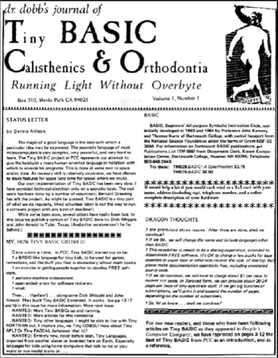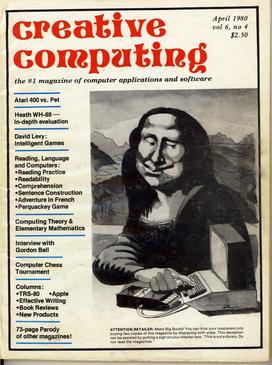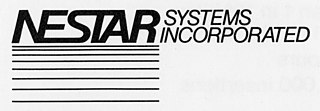Related Research Articles

Coleco Industries, Inc. was an American company founded in 1932 by Maurice Greenberg as The Connecticut Leather Company. It was a successful toy company in the 1980s, mass-producing versions of Cabbage Patch Kids dolls and its video game consoles, the Coleco Telstar dedicated consoles and ColecoVision. While the company ceased operations in 1988 as a result of bankruptcy, the Coleco brand was revived in 2005, and remains active to this day.

Xenix is a discontinued version of the Unix operating system for various microcomputer platforms, licensed by Microsoft from AT&T Corporation in the late 1970s. The Santa Cruz Operation (SCO) later acquired exclusive rights to the software, and eventually replaced it with SCO UNIX.
Tiny BASIC is a family of dialects of the BASIC programming language that can fit into 4 or fewer KBs of memory. Tiny BASIC was designed in response to the open letter published by Bill Gates complaining about users pirating Altair BASIC, which sold for $150. Tiny BASIC was intended to be a completely free version of BASIC that would run on the same early microcomputers.

Li-Chen Wang is an American computer engineer, best known for his Palo Alto Tiny BASIC for Intel 8080-based microcomputers. He was a member of the Homebrew Computer Club and made significant contributions to the software for early microcomputer systems from Tandy Corporation and Cromemco. He made early use of the word copyleft, in Palo Alto Tiny BASIC's distribution notice "@COPYLEFT ALL WRONGS RESERVED" in June 1976.

The Homebrew Computer Club was an early computer hobbyist group in Menlo Park, California, which met from March 1975 to December 1986. The club had an influential role in the development of the microcomputer revolution and the rise of that aspect of the Silicon Valley information technology industrial complex.

Dr. Dobb's Journal (DDJ) was a monthly magazine published in the United States by UBM Technology Group, part of UBM. It covered topics aimed at computer programmers. When launched in 1976, DDJ was the first regular periodical focused on microcomputer software, rather than hardware. In its last years of publication, it was distributed as a PDF monthly, although the principal delivery of Dr. Dobb's content was through the magazine's website. Publication ceased at the end of 2014, with the archived website continuing to be available online.

The Coleco Adam is a home computer and expansion device for the ColecoVision by American toy and video game manufacturer Coleco. The Adam was an attempt to follow on the success of the company's ColecoVision video game console. It was available as Expansion Module #3 for the ColecoVision, converting it into a home computer, and as a standalone unit. As such, it had the benefit of being entirely compatible with all ColecoVision games and peripherals. The computer came with 64 KB of memory, a tape drive for a proprietary medium called Digital Data Packs, a daisy wheel printer, and productivity applications, along with two DDPs for SmartBASIC and Buck Rogers: Planet of Zoom Super Game. It was released in October 1983 with the initial price of $700.

Creative Computing was one of the earliest magazines covering the microcomputer revolution. Published from October 1974 until December 1985, the magazine covered the spectrum of hobbyist/home/personal computing in a more accessible format than the rather technically oriented Byte.

Paul Terrell is an American businessman. In December 1975, he founded Byte Shop, the first personal computer retailer shop. He helped popularize personal computing to the hobbyist and home computing markets, and was the first retailer to sell an Apple Computer, the Apple I.
Ohio Scientific, Inc., was a privately owned American computer company based in Ohio that built and marketed computer systems, expansions, and software from 1975 to 1986. Their best-known products were the Challenger series of microcomputers and Superboard single-board computers. The company was the first to market microcomputers with hard disk drives in 1977.

The history of the personal computer as a mass-market consumer electronic device began with the microcomputer revolution of the 1970s. A personal computer is one intended for interactive individual use, as opposed to a mainframe computer where the end user's requests are filtered through operating staff, or a time-sharing system in which one large processor is shared by many individuals. After the development of the microprocessor, individual personal computers were low enough in cost that they eventually became affordable consumer goods. Early personal computers – generally called microcomputers – were sold often in electronic kit form and in limited numbers, and were of interest mostly to hobbyists and technicians.

Altos Computer Systems was founded in 1977 by David G. Jackson and Roger William Vass Sr. It focused on small multi-user computers, starting with multi-user derivatives of CP/M, and later including Unix and Xenix-based machines. In its 1982 initial public offering on NASDAQ, the company raised $59M. Thereafter the company's stock was traded under the symbol ALTO.

Byte was a microcomputer magazine, influential in the late 1970s and throughout the 1980s because of its wide-ranging editorial coverage.
Ramtek Corporation was a California-based manufacturer of computer display terminals founded in 1971. Co-founders Charles E. McEwan and John W. Metzler had previously worked together at the computer graphics division of Data Disc Corporation and founded Ramtek to create devices for displaying information from computer systems. Their major business was in medical monitors, as well as creating high-end graphical terminals for industrial and academic use. In 1973, they became one of the earliest manufacturers of video games, and manufactured coin-operated games until 1979. They became a publicly traded company starting in 1979. In 1981, it was reported Ramtek was the top company in the field of raster graphics display terminals.

A BASIC interpreter is an interpreter that enables users to enter and run programs in the BASIC language and was, for the first part of the microcomputer era, the default application that computers would launch. Users were expected to use the BASIC interpreter to type in programs or to load programs from storage.

Nestar Systems, Inc., was an early independent manufacturer of pre-internet local area networks for personal computers from 1978 to 1986 and was considered "a pioneer in the industry". It produced three major generations of products:
Smoke Signal Broadcasting, Inc. (SSB), later known as Smoke Signal, was an American computer company founded in 1976 by Frederic Jerome "Ric" Hammond of Hollywood, California. The company earned its reputation by offering expansions for the Southwest Technical Products (SWTPC) 6800 microcomputer. It later manufactured its own line of computers, called the Chieftain. Though it remains little-known, Smoke Signal was an early and important manufacturer of multi-user computer systems.
Gimix, Inc., was an American electronics and computer company based in Chicago, Illinois, founded by Robert C. Philips. Established in 1975, the company was initially Philips's vehicle for selling his various remote-controlled devices he had developed as the result of a life-long interest in electronics and experiments with home automation for himself and other clients. In 1979, the company introduced the first in a series of 68xx-based microcomputers dubbed the Ghost. It proved successful among various businesses and universities and allowed the company to survive into at least the early 1990s.
Gnat Computers, Inc. was an American computer company based in San Diego, California, founded in 1976. The company was an early developer of microcomputers and one of the first to license the CP/M operating system from Digital Research. They released various computer hardware, including two microcomputer systems, before they were acquired by business partner Data Technology Industries, Inc., in 1983.

Tava Corporation was a short-lived American computer company active from 1983 to 1984 based in Irvine, California, that was an early manufacturer of IBM PC compatibles. It also operated the CompuShack chain of franchised computer retail stores across the United States.
References
- 1 2 Myers, Myron K. (August 4, 1976). "People-oriented computer idea starts new company". Palo Alto Times: 7 – via Newspapers.com.
- 1 2 "Lomac Moves as 'Adam' Steps Up". The Times: 27. October 26, 1976 – via Newspapers.com.
- ↑ "Computer manufacturer seeks Ukiah area site". Ukiah Daily Journal: 1. February 10, 1975 – via Newspapers.com.
- 1 2 "Proposed Peers plant delayed by challenge". Ukiah Daily Journal: 1. March 20, 1975 – via Newspapers.com.
- ↑ Barean, P. D. (March 27, 1975). "Ukiah computer plant plan brings protests". The Press Democrat: 2 – via Newspapers.com.
- 1 2 3 4 Leslie, Neale (June 11, 1975). "Ukiah computer plant sets production date". The Press Democrat: 2 – via Newspapers.com.
- ↑ Leslie, Neale (June 15, 1975). "Computer industry thinks small". The Press Democrat: 51 – via Newspapers.com.
- 1 2 "Logical's Tempest Teapot Blows Over". The Times: 21. February 9, 1976 – via Newspaper.com.
- ↑ Fox, Stephen (May 9, 1976). "Computer programs itself, talks back". Times-Advocate: 25 – via Newspapers.com.
- ↑ Staff writer (January 26, 1976). "Computer Firm Bows to Now; 'Eve' Is Gone". The Chico Enterprise-Record: 15 – via Newspapers.com.
- ↑ "Logical Machine Corp. to double plant size". Palo Alto Times: 34. July 29, 1977 – via Newspapers.com.
- ↑ s (January 8, 1978). "Humanizing computers". San Francisco Examiner: 182 – via Newspapers.com.
- 1 2 "Computer firm buys Byte, Inc". Palo Alto Times: 27. December 5, 1977 – via Newspapers.com.
- ↑ Voakes, Paul (June 6, 1978). "Microcomputer stores catching on fast". Palo Alto Times: 49 – via Newspapers.com.
- 1 2 Voakes, Paul (July 11, 1978). "Logical step: Conversational computers". Palo Alto Times: 25 – via Newspapers.com.
- 1 2 3 Voakes, Paul (January 24, 1979). "'Doctor's' out of work—again". Palo Alto Times: 25 – via Newspapers.com.
- ↑ "Business notebook". Palo Alto Times: 37. August 31, 1978 – via Newspapers.com.
- ↑ Osborne, Adam (September 1, 1980). "From the Fountainhead". InfoWorld. CW Communications. 2 (15): 11 – via Google Books.
- ↑ "Logical Business Machines to Sell Turnkey Systems in U.S." Computer Systems News. UBM LLC (160): 62. April 23, 1984 – via Gale.
- ↑ "Business Micro Said to Incorporate Development Tool for Non-DPers". Computerworld. CW Communications. 17 (51): 39. December 19, 1983 – via Gale.
- ↑ "Logical Business Machines Enters Local-Area-Network Market". Computer Systems News. UBM LLC: 50. May 28, 1984 – via Gale.
- ↑ "Coleco Denies Patent Claim". The New York Times: 1.30. June 11, 1983 – via ProQuest.
- ↑ "'Adam' Settlement". The New York Times: D.5. July 14, 1983 – via ProQuest.
- ↑ "Logical Files for Chapter 11 Protection". Computer Retail News. UBM LLC (61): 2. July 9, 1984 – via Gale.
- ↑ McCone, J. (September 9, 1985). "Logical Business Exits Chapter 11". Computer Systems News. UBM LLC: 41 – via Gale.